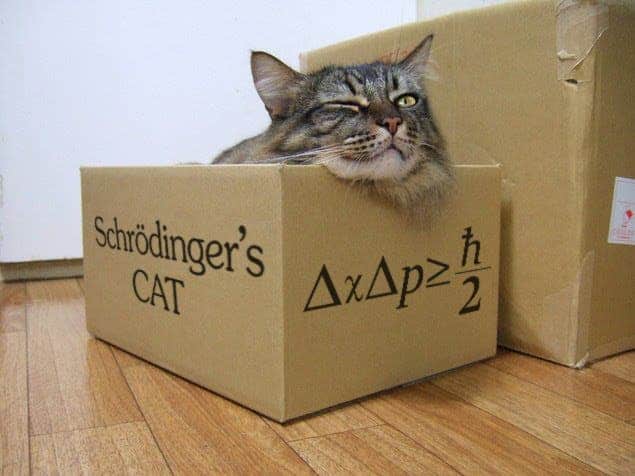Researchers at ETH Zurich “squeezed” the quantum states of a calcium ion to make it easily distinguishable, i.e. they measured one of its physical quantities more precisely. All while working within the confinements of Heisenberg’s Principle of Uncertainty (as if they had a choice). The findings could prove useful for ultra-precise measurements which are particularly sensitive to unwanted external influences.
Cat in the box

In 1935, in an attempt to mock the Copenhagen interpretation of quantum mechanics (hah, who got the last laugh?), Erwin Schrödinger proposed a thought experiment: a cat is placed in a sealed box along with a radioactive sample, a Geiger counter and a bottle of poison. If the Geiger counter detects that the radioactive material has decayed, it will trigger the smashing of the bottle of poison and the cat will be killed. Effectively, the cat’s life depends on the quantum mechanically determined state of a radioactively decaying atom. The ‘Copenhagen interpretation’ of quantum mechanics states that a particle exists in all states at once until observed. Conversely, the radioactive material can have simultaneously decayed and not decayed in the sealed environment. In follows, that Schrödinger’s cat is both alive and dead until you open the box. Of course, everyone thought this was absurd, but it’s the absurdity he was trying to convey in the first place about the Copenhagen interpretation in practical, everyday life.
“[It] prevents us from so naively accepting as valid a “blurred model” for representing reality,” Schrödinger wrote. “In itself, this would not embody anything unclear or contradictory.”
Without going into too many details, the radioactive atom and kitty are intimately “entangled” with each other. But once an observer opens the box, the “superposition” of the cat—the idea that it was in both states—would collapse into either the knowledge that “the cat is alive” or “the cat is dead,” but not both.
Now, Heisenberg’s uncertainty principle says that when dealing with any paired particles you can’t measure both quantities precisely. For instance, you can’t know with precision the position and, at the same time, the velocity of a quantum particle. The more accurately we know one of these values, the less accurately we know the other. There’s a sort of barter trade in nature, though: you can reduce or “squeeze” the uncertainty in one variable if you prepare the particle, and a team at ETH have demonstrated how this can be done.
Knowing your left from your right

Jonathan Home, professor of experimental quantum optics and photonics, and colleagues at ETH trapped a single electrically charged calcium ion in a tiny cage made of electric fields. Then laser beam shone on the ion cooled it until it hardly moved inside the cage (at absolute zero, atoms and molecules stop moving). Again, another laser light is shone only this time it “squeezes” the state of motion of the ion via spontaneous decay of its energy states. Eventually, the ion’s wave function (a statistical interpretation which tells you where the ion might be in space) gets squeezed, so physicists have a better idea of where the ion is located in space; at the same time the uncertainty in measuring the velocity increases proportionately.
“This state squeezing is an important tool for us,” Home explains. “Together with a second tool—the so-called state-dependent forces—we are now able to produce a ‘squeezed Schrödinger cat.’”
Here’s where the fun part starts. Futurity explains:
“To that end, the ion is once more exposed to laser beams that move it to the left or to the right. The direction of the forces induced by the laser depends on the internal energy state of the ion. This energy state can be represented by an arrow pointing up or down, also called a spin.
If the ion is in an energy superposition state composed of “spin up” and “spin down”, the force acts both to the left and to the right. In this way, a peculiar situation is created that is similar to Schrödinger’s cat: the ion now finds itself in a hybrid state of being on the right (cat is alive) and on the left (cat is dead) at the same time. Only when one measures the spin does the ion decide whether to be on the right or on the left.”
This technique makes it easier to distinguish between the “left” and “right” states, the researchers write in Nature.
“Even without the squeezing our “cat” is the largest one produced to date,” Home points out. “With the squeezing, the states “left” and “right” are even more distinguishable—they are as much as sixty times narrower than the separation between them”.
Decoherence in quantum systems is a major challenge in quantum computers. These sort of techniques could be used to improve stability and allow computers which rely on quantum superposition states to do their calculations. It’s not so good for squeezing non-quantum felines, though.


